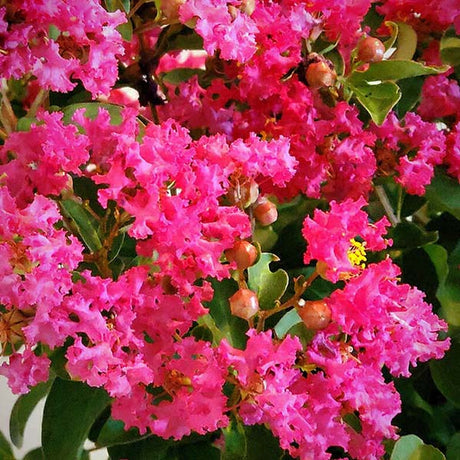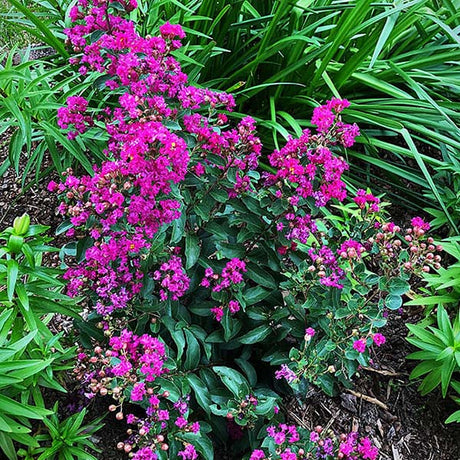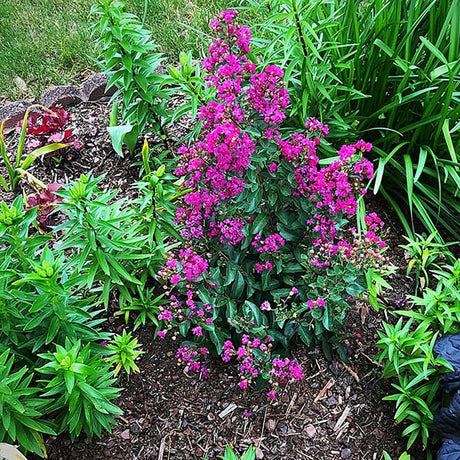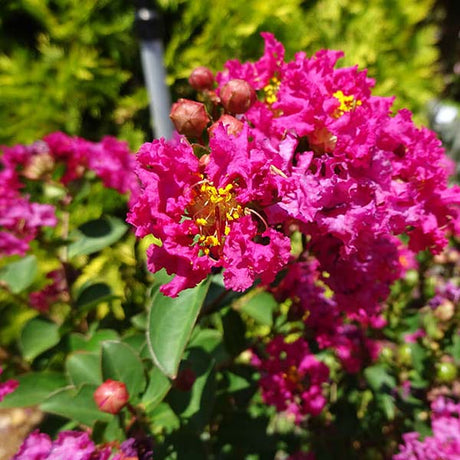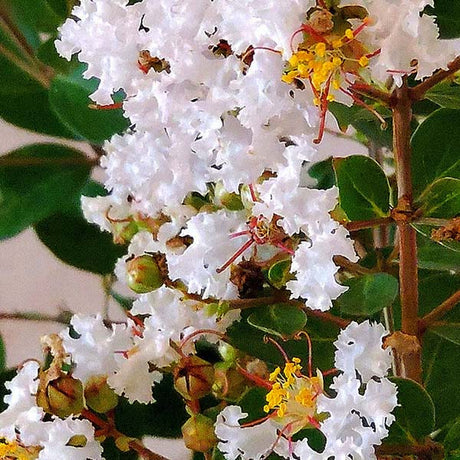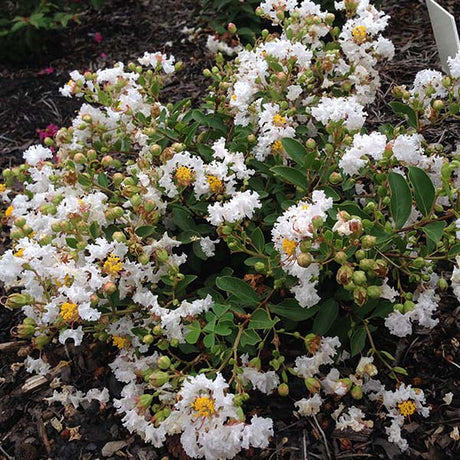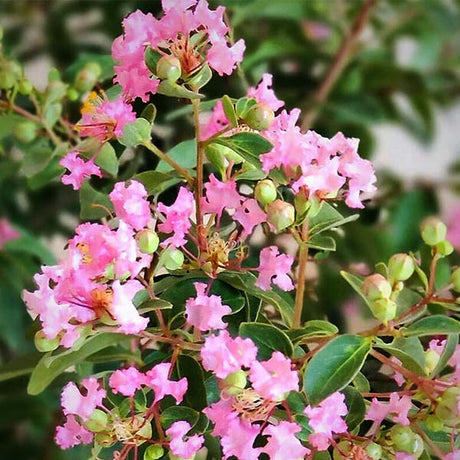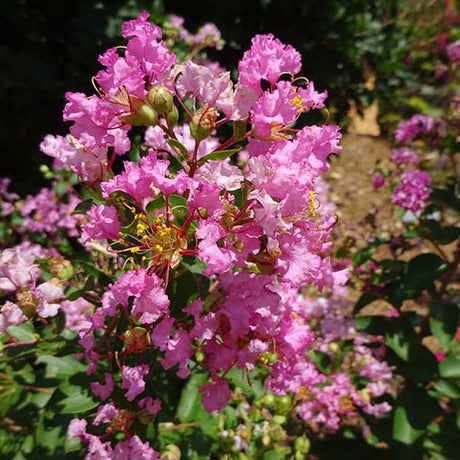- Sold outRegular price $9989Unit price /Unavailable
- Sold out
Cherry Delight Crape Myrtle Shrub
Regular price From $9952Unit price /Unavailable - Sold out
French Vanilla Crape Myrtle Shrub
Regular price $9978Unit price /Unavailable - Sold out
Cotton Candy Crape Myrtle Shrub
Regular price $13961Unit price /Unavailable
Bright, bold color and big performance in a compact size, meet the GreatMyrtle™ Crape Myrtle series by GardenChoice!
These innovative Lagerstroemia shrubs deliver everything gardeners love about traditional Crape Myrtles, long bloom seasons, rich flower color, and easy care, in a smaller, more versatile form. GreatMyrtle™ shrubs are cold-hardy, early-blooming, and perfect for containers, borders, or small garden spaces.
Each variety bursts with large clusters of crinkled flowers that appear weeks earlier than standard Crape Myrtles and continue right up until frost. Their dense, umbrella-shaped form and bright green foliage provide structure and texture even when not in bloom.
Key Benefits of GreatMyrtle™ Crape Myrtles
- Compact and mounded shape fits perfectly in containers, borders, or small landscapes
- Early and extended bloom time, flowers from early summer through frost
- Cold-hardy roots that regrow even in Zone 5 gardens
- Low maintenance with minimal pruning needed
- Pollinator-friendly, attracts bees and butterflies
- Multiple color options, including Cherry Delight, Cotton Candy, French Vanilla, and Red Velvet
- Reliable performance in both northern and southern climates
Effortless Care and Lasting Beauty
Gardeners of all levels will love how simple GreatMyrtle™ shrubs are to grow and maintain. These plants thrive in full sun and well-drained soil, and they reward minimal care with months of vibrant blooms.
Once established, they’re drought-tolerant and low-maintenance, needing only light pruning in late winter or early spring. For proper shaping and to avoid overcutting, see how to prune Crape Myrtles the right way. In colder climates, the roots remain hardy and will resprout after winter, so you can enjoy their dependable performance year after year.
Not sure if these will thrive where you live? Use our Plant Zone Finder to check your USDA growing zone.
Explore the GreatMyrtle™ Varieties
Each GreatMyrtle™ offers its own burst of color and charm:
-
Cherry Delight: Rich cherry-red blooms and lush green foliage, a true standout.
-
Cotton Candy: Soft pink flowers that light up garden beds and patio pots.
-
French Vanilla: Creamy white blooms that glow beautifully in evening light.
- Red Velvet: Deep red blossoms for bold, dramatic color all season.
These compact bloomers grow around 2 to 3 feet tall and wide, forming neat mounds of color that won’t overpower your landscape design.
Bring home the GreatMyrtle™ difference!
These modern crape myrtles bring early color, easy care, and a perfect fit for any landscape. Order yours today and enjoy long-lasting blooms from GardenChoice, available through Nature Hills Nursery.
Family-owned and operated since 2001, Nature Hills Nursery proudly offers high-quality plants backed by our Product Guarantee. Learn more about planting and care with our Planting Guide.
FAQ's for Buying GreatMyrtle™ Crapemyrtles Online
What makes GreatMyrtle™ Crapemyrtles different from traditional crape myrtle varieties?
What makes GreatMyrtle™ Crapemyrtles different from traditional crape myrtle varieties?
Breeders selected GreatMyrtle™ cultivars for earlier bloom, umbrella‑shaped canopies, and superior cold tolerance. Each introduction is trialed for multiple seasons; only those that flower weeks ahead of standard Lagerstroemia indica and maintain dense branching without heavy pruning are released. Because they bloom on new wood, they keep producing color from mid‑summer until frost, even after deadheading. This combination of extended season, showier form, and reliable performance in cooler zones sets them apart before any buying decision.
How cold‑hardy are GreatMyrtle™ Crapemyrtles, and can they thrive in northern climates?
How cold‑hardy are GreatMyrtle™ Crapemyrtles, and can they thrive in northern climates?
Most crape myrtles survive only to USDA Zone 7, but GreatMyrtle™ selections are root‑hardy to Zone 6 —and some to Zone 5 with protection. The plants die back to the crown when winter lows drop below 0 °F, yet vigorous new shoots emerge each spring and bloom the same year. To maximize survival north of Zone 6: plant in full‑sun, well‑drained soil; mound 3–4 in. of mulch over the root zone after the first hard freeze; and avoid late‑season nitrogen that can delay dormancy. Following these steps lets gardeners in Chicago, Detroit, or Boston enjoy crape myrtle color once thought impossible.
What planting and care routine ensures abundant blooms on GreatMyrtle™ Crapemyrtles?
What planting and care routine ensures abundant blooms on GreatMyrtle™ Crapemyrtles?
1) Choose the right spot: Six‑plus hours of direct sun fuels maximum flower bud set. 2) Prepare the soil: Blend 2 – 3 in. of compost into the top foot of native soil to improve drainage and fertility. 3) Plant slightly high: Set the root ball 1 in. above grade to prevent waterlogging. 4) Water deeply: For the first growing season, soak the root zone whenever the top 2 in. are dry; deep, infrequent watering encourages a broad root system. 5) Mulch lightly: A 2‑in. organic layer moderates temperature and moisture without smothering the crown. 6) Feed sparingly: Apply a balanced, slow‑release fertilizer in early spring only; excess nitrogen pushes leaves at the expense of blooms. By following this sequence—site, soil, water, mulch, nutrition—gardeners create the conditions GreatMyrtle™ needs to deliver its signature heavy flower clusters.
Do GreatMyrtle™ Crapemyrtles need pruning, and how can I keep their natural umbrella form?
Do GreatMyrtle™ Crapemyrtles need pruning, and how can I keep their natural umbrella form?
Because GreatMyrtle™ cultivars are bred for dense branching, minimal pruning is required. In late winter or very early spring, before new growth starts, remove any dead wood and thin crossing branches to improve airflow. Avoid “crape murder” (topping), which removes the buds that form on the tips. Instead, shorten stems by no more than one‑third to shape. Summer deadheading of spent clusters can encourage a quick secondary flush of color. This light‑handed approach preserves the umbrella canopy that defines the series while keeping the plant healthy.
Can GreatMyrtle™ Crapemyrtles be grown in containers or as die‑back shrubs, and how do I protect them through winter?
Can GreatMyrtle™ Crapemyrtles be grown in containers or as die‑back shrubs, and how do I protect them through winter?
Yes. Select a container twice the width of the nursery pot with drainage holes. Use a peat‑based mix amended with compost for moisture retention. Water whenever the top inch dries, and fertilize lightly each spring. In Zones 7‑9, leave pots outdoors; in Zones 5‑6, shift them to an unheated garage or wrap the container with burlap stuffed with leaves to insulate roots. In the ground north of Zone 6, treat GreatMyrtle™ as a die‑back shrub: prune stems to 6 in. in late fall, mound mulch over the crown, and uncover in early spring. These steps protect roots, ensuring vigorous regrowth and blooms season after season.

